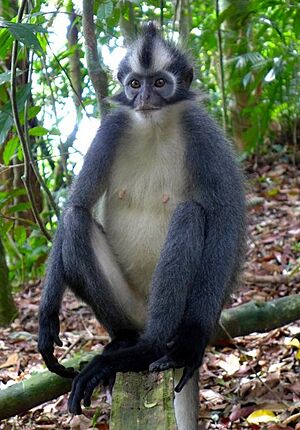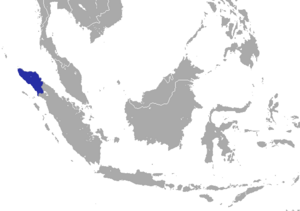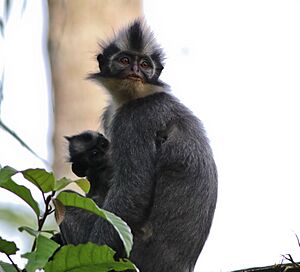Thomas's langur facts for kids
Quick facts for kids Thomas's langur |
|
|---|---|
 |
|
| Adult at the Bukit Lawang sanctuary. | |
| Conservation status | |
| Scientific classification | |
| Genus: |
Presbytis
|
| Species: |
thomasi
|
 |
|
| Thomas's langur range | |
The Thomas's langur (Presbytis thomasi) is a type of monkey. It is also called the North Sumatran leaf monkey or Thomas's leaf monkey. This animal belongs to the primate family called Cercopithecidae.
These langurs live only in northern Sumatra, Indonesia. This means they are endemic to that area. They do not live south or east of Lake Toba, or the Alas and Wampu rivers. Their natural home is in warm, dry forests. Sadly, they are losing their homes because of habitat loss. Local people call them reungkah in Acehnese and kedih in Alas. You can find many of them in Gunung Leuser National Park.
Contents
What Do Thomas's Langurs Eat?
Thomas's langurs mostly eat leaves. This is why they are called "leaf monkeys." They are also known as folivores. But they also enjoy other foods! They eat fruit, flowers, and sometimes even toadstools and snails.
Like other monkeys in their group, Thomas's langurs can digest tough plant material. They have special tiny living things, called microbes, in their stomachs. These microbes help them get nutrients from leaves. When they eat fruit, it's often unripe. This helps protect the important microbes in their gut. Thomas's langurs also drink water from holes in trees or small puddles.
How to Recognize a Thomas's Langur
Thomas's langurs have a unique look. The hair on top of their head stands up like a mohawk. This crown of hair is white at the front. A dark grey stripe runs down the middle.
They also have two fluffy tufts of fur on each side of their face. Their belly is a creamy white color. The fur on their back is grey. They have amber-colored eyes with grey rings around them. Baby Thomas's langurs look different. They have creamy white fur when they are young.
Where Do Thomas's Langurs Live?
These langurs live in the wild for about 20 years. But in zoos, they can live longer, up to 29 years. This might be because they have less stress and no predators in captivity.
Who Are Their Predators?
Thomas's langurs have several natural enemies. These include clouded leopards, Sumatran tigers, bay cats, and reticulated pythons. These predators are especially dangerous when the langurs are on the ground.
Thomas's langurs also help their environment. When they eat fruits, they spread the seeds. This helps new plants grow. They also help pollinate flowers when they feed on them.
Why Are Thomas's Langurs in Danger?
Thomas's langurs are facing a big threat. Their homes in the Leuser and Ulu Massen Ecosystems in Northern Sumatra are being cut down. This deforestation puts them at risk of extinction.
Indonesian law protects these langurs. They are listed under CITES Appendix II. The IUCN also lists them as "Vulnerable." This means they are at high risk of becoming extinct in the wild.
Other famous animals like the Sumatran orangutan and Sumatran elephant are even more endangered. But the number of Thomas's langurs has dropped by 30 percent in recent years. As their habitat shrinks, they sometimes move into farms. Here, they can be seen as pests by farmers. Sadly, some are hunted with guns. They can also be caught and sold illegally as pets.
Even though they are protected, some Thomas's langurs are getting too used to people. Tourists visit Gunung Leuser National Park. Even though it is not allowed, some people feed the monkeys. This can be bad for the animals and for people.



